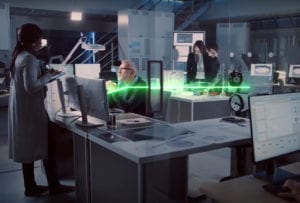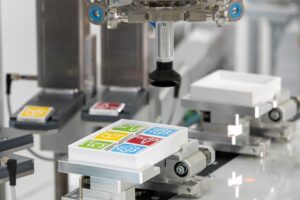In today’s chaotic marketplace, manufacturing leaders must bridge the divide between the Information technology (IT) systems in their offices and the operational technology (OT) systems in their plants, warehouses, and labs. Important evolutions such as cloud computing (to capture and analyze large quantities of data), edge control (to reduce data latency and enable faster local decisions), and intelligent, connected devices now make it possible to accelerate IT/OT convergence and drive much higher levels of manufacturing efficiency and uptime. According to the recent Forrester report, “Practical Guide To Bridging The IT/OT Divide,” a key to success is to align IT/OT integration strategies with evolving devices and applications.
Adapting to these evolutions can enable productivity efficiency gains on multiple levels. For example, manufacturers can now access streaming analytics and integrate data between IT systems that capture online orders and the OT systems that execute them, driving faster delivery and a better overall customer experience.
Factors that are simplifying the migration to an IT/OT convergence world
Similar to how IT systems developed from hardware-focused to software-driven, OT systems are now evolving in the same manner, such as:
- Industrial automation hardware getting “smarter” – Modern programmable logic controllers (PLCs) are equipped with more memory and powerful processors than traditional devices. This enables them to utilize more sophisticated operating systems, like Linux, which are popular in the IT world. By supporting such operating systems, the OT world can now easily access portable software add-ons that help optimize all phases of manufacturing operations.
- OT hardware vendors expanding partnerships with software firms – OT vendors are acquiring and/or partnering with companies to extend solution functionality. For example, the EcoStruxure™ platform integrates industry-specific software solutions from AVEVA (formerly Wonderware) and ProLeiT (acquired by Schneider Electric in 2020). This broad software portfolio offers hardware-agnostic smart solutions that rapidly optimize manufacturing operations while reducing carbon emissions.
- Standards enable software development and tighter cybersecurity – Standards like IEC 61499 allow application-centric design by separating the application model from the system model. Application programming is executed independently of the underlying control devices, resources, automation hardware, and communications infrastructure topology, enabling a third-party software marketplace for OT applications. Other standards like IEC 62443 set the stage for OT cybersecurity standards that supplement robust cybersecurity levels traditionally offered through IT system firewall best practices.
- Open systems are replacing proprietary systems – Manufacturing operations have traditionally run OT industrial automation on proprietary software code. As a result, each device required specialist expertise to maintain machine code. This is now evolving to more open systems. By eliminating levels of programming complexity, more open systems make it possible to implement standards-based architectures that create step-change improvements in operations and faster time-to-market delivery of highly customized products.
- Adoption of universal automation – By decoupling hardware from software, the vendor-agnostic nature of universal automation means better IT/OT interoperability. This drives the reuse of existing assets in modern contexts–regardless of the supplier who produced them–providing an easy and cost-effective method for keeping systems flexible and up-to-date. Universal automation optimizes IT/OT convergence and sets the stage for self-configuring, self-healing, fast retooling systems that drive speed and agility.
IT/OT integration encompasses organizational realignment
Technology is just one piece of the IT/OT integration equation. Harmonization of application development operation techniques across IT and OT teams must also be achieved. IT benefits from a mature operating model governing incident management, secure application of software patches, and trusted upgrades to support new use cases.
Modern IT asset management and enterprise service management techniques and platforms can be applied to OT software development. By cross-training OT experts in IT disciplines such as development operations and data analysis, both teams become familiar with common tool sets and can communicate using the same language. Conversely, IT professionals are being cross-trained in PLC machine code. Forward-looking manufacturing firms are also bringing IT and OT teams into a common reporting line to further facilitate collaboration. Such initiatives foster the goal of mutual understanding of processes and culture.
For more information
Companies like Schneider Electric support transformation acceleration by providing platforms, EcoStruxure Automation Expert that capitalizes on IEC 61499-compliance software expertise. It spans plant operations’ monitoring, control, engineering, and orchestration layers to deliver process automation efficiencies across large global manufacturing organizations.
Download the Schneider Electric white paper “EcoStruxure Automation Expert – A Quantitative Comparison of Digitized Industrial Automation Systems” to learn more.




Conversation
Thank you for writing this article Fabrice and highlighting the impact of cybersecurity in IT/OT convergence!